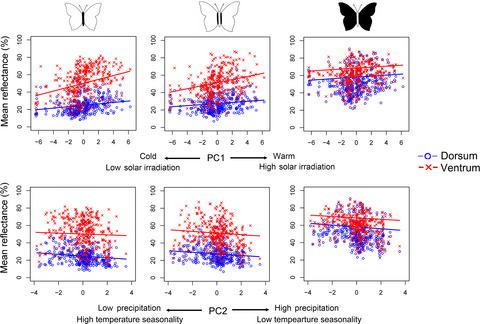当前位置:
X-MOL 学术
›
Ecol. Lett.
›
论文详情
Our official English website, www.x-mol.net, welcomes your
feedback! (Note: you will need to create a separate account there.)
Climate predicts both visible and near-infrared reflectance in butterflies
Ecology Letters ( IF 7.6 ) Pub Date : 2021-06-26 , DOI: 10.1111/ele.13821 Changku Kang 1 , Sehyeok Im 2, 3 , Won Young Lee 2 , Yunji Choi 4 , Devi Stuart-Fox 5 , Blanca Huertas 6
Ecology Letters ( IF 7.6 ) Pub Date : 2021-06-26 , DOI: 10.1111/ele.13821 Changku Kang 1 , Sehyeok Im 2, 3 , Won Young Lee 2 , Yunji Choi 4 , Devi Stuart-Fox 5 , Blanca Huertas 6
Affiliation

|
Climatic gradients frequently predict large-scale ecogeographical patterns in animal coloration, but the underlying causes are often difficult to disentangle. We examined ecogeographical patterns of reflectance among 343 European butterfly species and isolated the role of selection for thermal benefits by comparing animal-visible and near-infrared (NIR) wavebands. NIR light accounts for ~50% of solar energy but cannot be seen by animals so functions primarily in thermal control. We found that reflectance of both dorsal and ventral surfaces shows thermally adaptive correlations with climatic factors including temperature and precipitation. This adaptive variation was more prominent in NIR than animal-visible wavebands and for body regions (thorax-abdomen and basal wings) that are most important for thermoregulation. Thermal environments also predicted the reflectance difference between dorsal and ventral surfaces, which may be due to modulation between requirements for heating and cooling. These results highlight the importance of climatic gradients in shaping the reflectance properties of butterflies at a continent-wide scale.
中文翻译:

气候预测蝴蝶的可见光和近红外反射率
气候梯度经常预测动物着色的大规模生态地理模式,但其根本原因往往难以解开。我们检查了 343 种欧洲蝴蝶物种之间反射的生态地理模式,并通过比较动物可见光和近红外 (NIR) 波段来分离选择对热效益的作用。近红外光约占太阳能的 50%,但动物看不到,因此主要用于热控制。我们发现背侧和腹侧表面的反射率都显示出与包括温度和降水在内的气候因素的热适应性相关性。这种适应性变化在 NIR 中比动物可见波段和对体温调节最重要的身体区域(胸腹和基底翼)更为突出。热环境还预测了背侧和腹侧表面之间的反射率差异,这可能是由于加热和冷却需求之间的调制。这些结果强调了气候梯度在大陆范围内塑造蝴蝶反射特性的重要性。
更新日期:2021-08-10
中文翻译:

气候预测蝴蝶的可见光和近红外反射率
气候梯度经常预测动物着色的大规模生态地理模式,但其根本原因往往难以解开。我们检查了 343 种欧洲蝴蝶物种之间反射的生态地理模式,并通过比较动物可见光和近红外 (NIR) 波段来分离选择对热效益的作用。近红外光约占太阳能的 50%,但动物看不到,因此主要用于热控制。我们发现背侧和腹侧表面的反射率都显示出与包括温度和降水在内的气候因素的热适应性相关性。这种适应性变化在 NIR 中比动物可见波段和对体温调节最重要的身体区域(胸腹和基底翼)更为突出。热环境还预测了背侧和腹侧表面之间的反射率差异,这可能是由于加热和冷却需求之间的调制。这些结果强调了气候梯度在大陆范围内塑造蝴蝶反射特性的重要性。











































 京公网安备 11010802027423号
京公网安备 11010802027423号